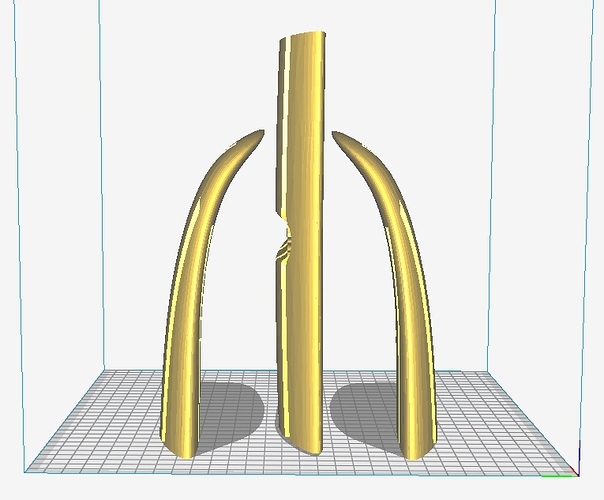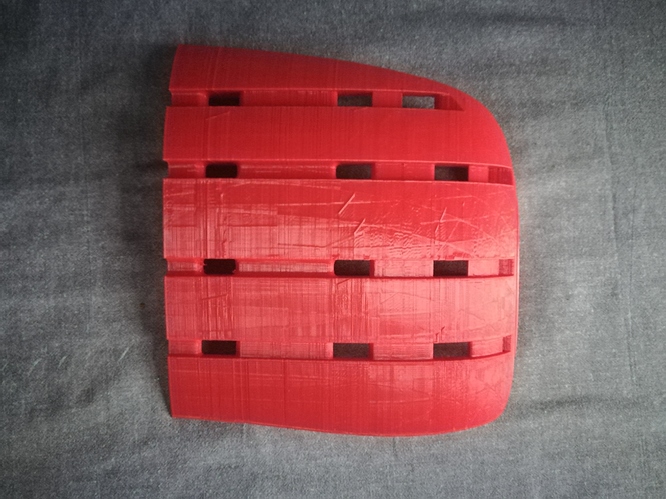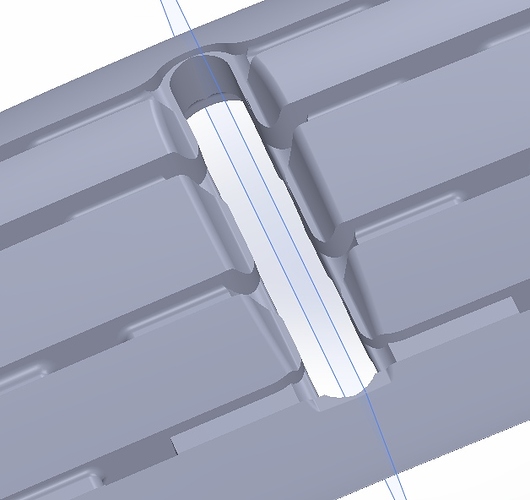An Optimist weighs about twice as much as a sup board with an efoil.
So if an Optimist can start flying at 5 knots, so should an e-foil …
I made the wing attached to be able to surf with my foil… the regular kitefoil wings are too fast to stay in the waves…
This wing is much thicker (almost 3cm) than the original one and has a loooot more surface area (20cm long and 60 cm wide)
To get a better feel for how it behaves, i took it for a ride with my kite.
It creates a lot of lift, as soon as you move it’s pushing up… i can go slower than walking speed and stay flying. I was actually so slow that my GPS didn’t record it as riding.
The drawback is that top speed is very limited and there a slight tendency to stall at extra low speed…
so you have to choose: Start slow, or ride fast 
Two options, have the wing fold backwards like one of those fighter jets, or add ailerons.
Very interesting indeed/ Did you use a specific airfoil profile, like NACA something ? I would love to 3D-print it !
I used a profile yes… it’s a S3010-103-84 . i have absolutely no idea why i picked this one 
The profile was true on the print, then the layers of fiberglass might have messed it up a bit…
It’s also true at the center, but get flatter on each sides.
For the rest of the shape, width and length are comparable to my original wing, the thickness come from scaling the model to the right length. And then i kept as much area as possible.
The model has holes and grooves to be filler later for strength (i don’t remember who but someone posted the idea on this forum)
I wanted full fiberglass for the place where the screws goes to be able to put them very tight.
Grooves and holes are filled with fiberglass, epoxy and some thickener.
Finally, there are 3 layer of fiberglass on top and 4 on the bottom.
it’s very rigid and it didn’t break so far, even after hitting the bottom a few times…
Looks nice mat, have you shared the STL files for this
fusion 360 file.
Top man…have you got any data for the surface areas for this design
The only data i know for sure is…: HUGE 
it’s kind of square, so it’s close 1200 square cm.
It’s not that much more than the foil fish wing i was using, the main difference that allow to fly it very slow is the profile and mainly the thickness i think …
Hi Mat and greetings from the South of France.
Thanks for the wing step file, really cool to be able to play with it on Solidworks
Is that the very thick version you have been talking about, or is the very thick version thicker than that one ?
Cheers
i printed exactly that one… but then the layers of fiberglass make it thicker.
i’m not sure exactly how much though…
i used 3 layers of 6oz glass on top, 4 on bottom, all vacuum bagged.
the 2 coats of resin/sanding to get it smooth, and finally some paint and clear coat …
Thank you Mat. It is printing now, half by half as my printer height does not exceed 40cm. An 18-hour print with supports, that is just for the first half 
it did it in 5 parts… and then welded them with acetone…
if you print in only 2 part, as it’s quite think compare to the height, you might have bad printing at the top as it starts vibrating…
i did 1/2 scale test prints and the curved parts ended up pretty bad…
and also, as the middle doesn’t have much plastic linking both sides, you might not want a weld at that place… splitting it with an uneven number let you have the middle in a single piece…
Ok I think I understand what you did. 3d print structure out of ABS, fill grooves and holes with filler, and glass over top and bottom. Right?
exactly… i used ASA to have less wrapping issues… wasn’t perfect but nothing some acetone can’t fix… i used it today with the kite for 3 hours, hitting the ground a few time, and it’s holding strong…
Overnight printing…
Exactly like Mat said, indeed, even with supports, a minor issue with the very last centimer at the tip. but this should be OK once sanded and filled. Thx again @Mat for your work.
PS : I used PLA at 225 degrees and no wrapping, at 0.3mm so there is some good sanding to be done.
@Mat how are you going to fix the mast to the wing please ? I am puzzled about the central whole / slit shape…
I left the big hole to get full resin where the screws clamp.
I didn’t made the holes until layup was finished.
fist: i filled up everything with a mix of chopped fiber and resin.
then i added the fiberglass…
using 3M super77 spray glue help to hold the fiber in place before wetting /bagging.
once all the fiber was cured, i used some sandpaper around the fuselage to get the right shape. or as close as possible.
finally i got interface right by adding some thickened epoxy, and screwing the fuselage in place. Do not forget to wax the screws and fuselage 
and finally, a few iteration of resin / sanding to get the shape as clean as possible. paint and clear coat next.
Just great 
So you did not place screw inserts before filling the central space with resin, like you would do for footstraps ?
You just waited for it to dry then did 3 holes right into the resin ?
Second question : I am worrying about the epoxy not sticking to the printed PLA. Did you cover the printed plastic with a layer of epoxy, let it dry then only add a mix of chopped fiber / epoxy ? Or did you pour straight the mix of chopped fiber / epoxy ?
Somewhere I also read that adding some sawdust and some milled fiber to the mix was also a good idea but I have never done it myself.
the threads are in the fuselage, so the wing has just simple holes…
i roughened up all the surface with very coarse sandpaper… it might have helped.
when i’m using epoxy to fill big volumes, i usually add aerosil, it’s some kind of very light white powder… it avoid the resin to heat up too much. i guess sawdust will have the same effect… not sure if it makes it stronger though… it help to have the epoxy not too liquid.


